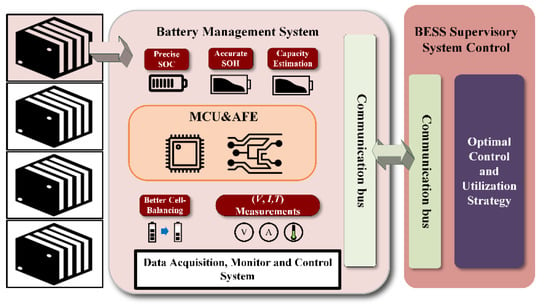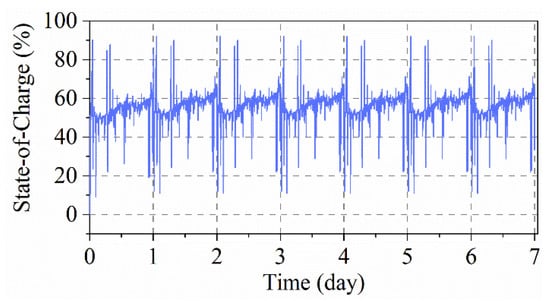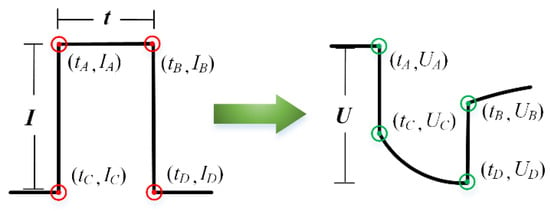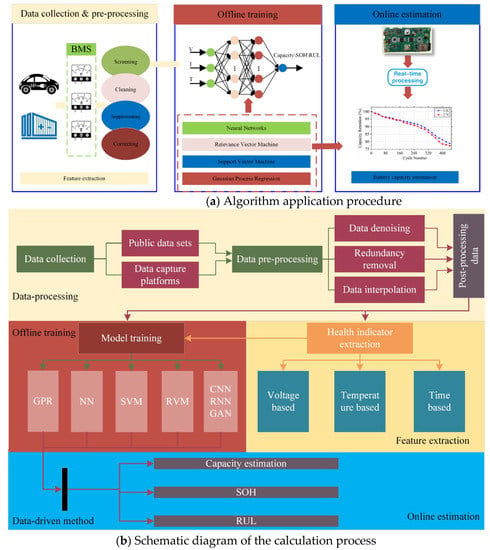With the widespread use of Lithium-ion (Li-ion) batteries in Electric Vehicles (EVs), Hybrid EVs and Renewable Energy Systems (RESs), much attention has been given to Battery Management System (BMSs). By monitoring the terminal voltage, current and temperature, BMS can evaluate the status of the Li-ion batteries and manage the operation of cells in a battery pack, which is fundamental for the high efficiency operation of EVs and smart grids. Battery capacity estimation is one of the key functions in the BMS, and battery capacity indicates the maximum storage capability of a battery which is essential for the battery State-of-Charge (SOC) estimation and lifespan management.
1. Introduction
On the background of energy crisis and global warming, applications such as renewable energy systems and new energy vehicles (Electric Vehicles (EVs) and Hybrid EVs) have become a necessary way of saving energy and decreasing carbon emission [
1,
2]. As the key component in the power supply of the EVs and Renewable Energy Systems(RESs) [
3,
4,
5], the energy management of the battery pack directly affects its performance in various operation conditions [
6,
7]. Due to its high energy density, long service life, no memory effect, etc. [
8,
9], the Lithium-ion (Li-ion) battery has become a first choice for EVs and RESs [
10]. For example, lithium iron phosphate (LFP) has a 90~140 Wh/kg energy density and up to 2000 life cycles, which usually consists of LiFePO
4 cathode and graphite anode. In addition, Li-ion battery chemistries also include lithium Nickel Manganese Cobalt oxide (NMC) and lithium Nickel Cobalt Aluminum oxide (NCA) with a higher energy density (140~250 Wh/kg) [
11]. Recently, battery manufacturers have also developed new products with relatively superior performance, such as the blade battery (LFP) from BYD which has good thermal safety characteristics through nail penetration tests [
12]. Thanks to its excellent properties, the scope of Li-ion batteries has also expanded to various areas like robots, Automated Guided Vehicles (AGVs) and consumer electronics. Especially, with the concept of low carbon, Li-ion batteries will play an important role in the future. According to Research and Markets research data in Statista [
13], the global lithium-ion battery scales to about 185 GWh in 2020, and the market is expected to grow to 950 GWh in 2026 as shown in
Figure 1.
Figure 1. Global battery demand 2020–2026.
A typical structure of the Battery Energy Storage System (BESS) is illustrated in
Figure 2, which mainly includes battery cells, Battery Management System (BMS), Power Conversion System (PCS), etc. Among all the components, BMS is responsible for the safety operation of the cells in the BESS. The functions of BMS include state estimation, voltage/temperature monitoring and fault diagnosis and warning. One key parameter here is the battery capacity representing the maximum Ah throughput at present. In essence, the battery capacity is the number and energy of the electrons inside the electrodes [
14,
15]. One consensus is that the Li-ion battery capacity will fade with battery degradation, which could be influenced by numerous external factors in operation conditions. Although the degradation of Li-ion battery can be briefly divided into two modes: Loss of Active Materials in electrodes (LAM), and Loss of Lithium Inventory (LLI), it is difficult to distinguish the aging modes in reality. However, the capacity of an Li-ion battery is critical for the energy management decision marking of BMS. For example, the battery State of Charge (SOC) represents current energy left, which is a ratio of the present Ah amount to its capacity [
16]. It is impossible to obtain an accurate SOC without knowing the battery capacity. Once a precise SOC is received, BMS can choose when to charge or discharge each cell. In order to avoid the overuse of the Li-ion battery, its capacity should also be clearly defined. Otherwise, safety hazards, such as failure and thermal runaway [
17,
18], may exist when the Li-ion battery reaches its End-Of-Life (EOL) [
19]. Capacity is also a fundamental index for the secondary use of the Li-ion battery [
20,
21]. In general, the battery capacity is especially important for the lifespan management of the cells by BMS [
22,
23].
Figure 2. Structure of the battery energy storage system.
Battery capacity is usually regarded as the indicator of its lifespan, and it is believed to reach its EOL once the battery capacity reaches 80% of its initial value [
24]. An accurate capacity can improve the accuracy of SOC estimation, thus enabling the users to perform charging operations and battery maintenance prompt. A slightly changed capacity will gradual deteriorate the battery’s electrical and thermal characteristics and further lead to other severe safety issues [
25]. However, a series of barriers hinder an accurately measurement of the Li-ion battery’s capacity. One primary fact is the capacity of Li-ion battery is related to current rate and temperature [
26,
27] considering the effect of electrode kinetics. Then, it is easy to understand that the Li-ion battery’s capacity greatly influences the working conditions of the battery pack, which increase the difficulties of obtaining an accurate battery capacity. Another critical factor is the limitation from BMS, the computing power of the microprocessor is limited due to the cost [
28]. It can be deduced that onboard implementable battery capacity estimation algorithms are still needed for most EV applications [
29,
30]. One expectation is that the fast development of Internet-of-Things (IoT) and artificial intelligence can improve the capacity estimation techniques for BMS [
31,
32].
2. Li-Ion Battery Degradation Mechanism Analysis
An Li-ion battery mainly contains the lithium metal oxide as the cathode, and graphite as the anode material at present. A separator exists between the two electrodes for insulation, which only allows the pass of Li-ions, and the electrons can only exchange through external circuits. Additionally, an electrolyte is also needed to assist the transfer of Li-ion. Thus, it is clear that the Li-ions exchange from the electrodes during battery charging and discharging [
37]. For EVs, the reduction of the battery capacity results in less energy available, which directly reflects the performance degradation of the battery pack. The capacity loss of the battery is a non-linear process containing complex aging mechanism. However, the aging mechanism of batteries cannot be precisely described, especially for the decay rules of cycle life. To conveniently analyze the battery degradation, recent research usually divides the battery aging into two main forms: calendar aging and cycling aging [
38,
39,
40,
41].
Calendar aging refers to the capacity loss during storage, which is mainly influenced by high temperature and SOC [
42,
43,
44]. Five aging cases are set in [
43] for the calendar aging of 15 Li-ion batteries for a period between 24 and 36 months. The test results clearly prove there is a non-linear battery degradation during calendar aging, and the fading rate of the Li-ion battery is accelerated by increased storage temperature and SOC. Among all the influencing factors, high storage temperature is believed to be the most critical factor for battery calendar degradation [
45,
46]. LLI is the main reason for calendar aging with high temperature [
15].
3. Review of Capacity Estimation Methods
Considering the complexity of battery degradation, it is still challenging for the BMS to accurately predict the battery capacity onboard. Thus, researchers have made significant efforts to solve this problem. This section will brief introduces the battery capacity estimation methods in the literature. We mainly divide the methods into direct measurement methods, analysis-based methods, SOC-based methods and data-driven methods, whose principle and current processes will be detailed in the following subsection.
- A.
-
Direct Measurement Method
The most straightforward way to receive the battery capacity is to accumulate the charge during its cycling period [
57]. Direct measurement methods need a full charge or discharge of the battery under a specific condition. Current various standards from International Electrotechnical Commission (IEC) [
58], International Organization for Standardization (ISO) [
59] and Institute of Electrical and Electronics Engineers Standards Association (IEEE-SA) [
60] have been proposed for testing the Li-ion battery capacity in a standard condition. For example, ref. [
58] defines a 1/3
It constant discharging current for EV and 1
It discharging current for HEV, for the purpose of measuring the battery capacity. As for the capacity measurement in [
59], 1 C current is recommended for discharging the high power battery and C/3 is used for measuring high energy battery. It is not difficult to realize that the measured battery capacity may not be the same for different C-rates and temperature settings in those standards. In addition, the test procedure is rather strict compared with the working environment of the battery pack in a real application. [
58] needs the battery soaked at a predefined temperature for at least 12 h to ensure thermal stabilization, which requires the cell temperature changes lower than 1 °C in 1 h time interval. The current and voltage measurement accuracy should be less than +/− 1%, and the time is measured less than +/− 0.1% in [
59]. Thus, it is not practical to always meet the above requirements in a battery application, which limits these test methods to laboratory tests as references.
Another concern is that in reality, the BESS cannot always fully charge or discharge in various load conditions. Direct measurement methods cannot give a result if the battery is partially charged or discharged, which often happens in real cases. To clarify this point, an SOC profile of BESS for primary frequency regulation lasting one week [
31] is shown below in
Figure 6. Mostly, the SOC of the BESS varies within 40–60%, which confirms the unrealistic implement of direct measurement methods in a real application. It is noted that fully charging or discharging the battery is also quiet time-consuming [
61].
Figure 6. SOC profile of BESS for the primary frequency regulation of grid.
For convenience, an option is to measure the internal resistance to reflect the battery capacity. The battery internal resistance can be directly measured by applying a current pulse to the battery [
62] as shown in
Figure 7. Usually, the current pulse lasts a few seconds, and then the internal resistance can be calculated by the following Equation,

Figure 7. The DC internal resistance measurement for Li-ion battery.
Unfortunately, the internal resistance is more related to the power fade of the battery, which does not always exhibit a linear relationship with capacity fade. The capacity degradation is related to lithium corrosion at the anode, while the power fade is related to SEI growth and LAM [
63]. Moreover, the internal resistance measurement is also affected by C-rate, temperature and SOC, and the internal resistance is quite small in the milliohm range [
43,
64,
65]. Thus, some uncertainties may exist if only internal resistance is used for calculation. Direct measurement methods are strictly performed by charging and discharging of the battery in laboratories. As for onboard BMS implementation, the practical application requires estimation methods that can be done with limited complexity.
Therefore, more advanced methods are needed to estimate the battery capacity by processing the current, voltage, temperature and mechanical stress. Those existing methods include analysis-based methods, SOC-based methods and data-driven methods, which will be introduced in the following subsections.
- B.
-
Analysis-Based Methods
For indirect methods, the voltage, current and temperature can be recorded by sensors, and then used to estimate the capacity. In this work, we mainly introduce five kinds of analysis-based methods with IC (Incremental curve) curve, DV (Differential voltage) curve, DT (Differential thermal) curve, mechanical stress and Electrochemical Impedance Spectroscopy (EIS) as shown
Figure 8. At present, more attention is paid to the Li-ion battery capacity. The capacity, which limits the available energy, is the key indicator for State-Of-Health (SOH), which is defined as the ratio of current maximum capacity to its initial capacity [
66].

where Qpresent denotes the current capacity and Qinitial is the nominal capacity. Thus, we will not distinguish capacity estimation and SOH estimation in the following explanations.
Figure 8. Schematic of analysis-based method.
- C.
-
SOC-based method
An SOC-based methods can be divided into SOC indirect estimation and the SOC observer-based method, which is illustrated in Figure 11. SOC indirect estimation calculates the battery capacity through a period of Coulomb counting and SOC variation, which usually estimates the battery in a short time scale online. The SOC observer-based method directly estimates the battery capacity utilizing an observer based on battery Equivalent Circuit Model (ECM) model, which uses only current and voltage as the input, and SOC and capacity can be estimated synchronously.
Figure 11. SOC-based method.
- D.
-
Data-driven method
With the fast development of IoT and artificial intelligence, the daily operation measurement of the battery system is easy to be recorded to a cloud platform which could be further used for cloud to edge estimation. The data-driven approach is characterized by a reliance on a large amount of dataset to make decisions and does not require a specific battery model. In a data-driven approach, a model can be used to map the data as long as a sufficiently representative sample is available, without the need to pre-determine a definitive model in advance. In the case of batteries, the operation measurement that we can collect may contain aging information. The degree of aging can be reflected by certain characteristics during the charging and discharging process, and the data-driven approach constructs an approximate model to match the true aging situation with this information. Figure 15a is a schematic diagram of the data-driven approach application procedure, which mainly includes three processes: data collection & preprocessing, offline training and online estimation. The main purpose of data collection is measuring the voltage, current and temperature during the operation of the battery pack. Then, the data-driven model can be trained offline with high computing power processor, and the trained model is later implemented in a BMS for online estimation. In this type of method, the keys lie in the processing of the data, the extraction of key features and model training, the main data stream of those processes is shown in Figure 15b.
Figure 15. The basic process of the data-driven approach.
The existing data-driven method is introduced in the following subsections.
Neural Network (NN): The basic NN is a three-layer structure network including an input layer, hidden layer and output layer. The input layer neuron can be regarded as extracting capacity-related features [
153]. It is critical to choose a suitable indicator. Refs. [
154,
155] use NN to investigate the battery capacity. From the perspective of feature extraction, the former uses discharge voltage, while the latter adds also the temperature effects. The weight coefficients from the input layer to the hidden layer or from the hidden layer to the output layer need to be obtained after training a large number of samples [
105]. Ref. [
156] chooses to train a generalized regression NN with the battery’s constant current charging time to estimate SOH. The instantaneous discharging voltage drop and the amount of Ah-throughout for a certain depth of discharge are captured as features. Ref. [
157] uses the Broad Learning System (BLS) to process historical capacity data and generate feature nodes as the input layer of the neural network. This method does not require an in-depth study of the battery aging mechanism, but it also requires at least 25% of the historical capacity data.
Support Vector Machine (SVM): Support Vector Machine (SVM) is another technique. The core is to divide the data set in a hyperplane [
158,
159] so that the geometric interval between each data point can be maximized in the hyperplane. It can be transformed into an objective function under constraints to solve the optimization problem. Ref. [
160] studies the relationship between the electrolyte concentration and voltage with the battery capacity. The non-linear relationship is then fitted by SVM. A Least Squares Support Vector Machine (LSSVM) is used in [
161], with charging voltage, discharging current, temperature, and cycle times as inputs, and the residual sum of squares error is selected as the cost function to calculate the capacity retention rate. Ref. [
162] uses Particle Swarm Optimization (PSO) to find the suitable hyper-parameters for the SVM kernel function and trains the impedance values as the features to complete the battery SOH estimation.
Bayesian learning method: Bayesian methods solve the posterior information with assumed prior probabilities to infer the unknown parameters [
163]. There are a variety of data-driven methods that use their associated theory, such as the Relevance Vector Machine (RVM), which provides an output of posterior probabilities based on a Bayesian approach. Compared to SVM, it eliminates the need for model selection, but it often requires more training time. The literature uses empirical modal decomposition for battery capacity data, and sets up a multi-start prediction matrix to train RVM. It reduces the stochastic uncertainty associated with the starting point of a single prediction and parameter settings. GPR is derived from the Bayesian framework [
164], and uses the Gaussian process prior knowledge to perform regression analysis on the data. Ref. [
165] uses voltage segments in short periods during constant current operation as the input of GPR for capacity estimation. The non-parametric regression properties of the GPR technique allow the estimation to be adapted to the complexity of the data.
Deep learning method: Deep learning utilizes multiple hidden layers in the network [
32], which can reflect more complex mapping between the features and battery health. Methods, such as Convolutional Neural Network (CNN) [
166,
167], Recurrent Neural Network (RNN) [
168,
169] and Long Short-Term Memory (LSTM) [
170,
171] have been used for battery SOH estimation recently, and have shown promising performance in estimation accuracy. Ref. [
167] takes advantage of CNN and Transformers for accurate SOH estimation of Li-ion batteries, which utilizes the attention mechanism to extract more important features from the original measurement. A differential evolution grey wolf optimizer is used in [
171] to tune the hyperparameters of LSTM for an accurate battery health estimation. A hybrid of gate recurrent unit and CNN is shown to estimate the Li-ion battery SOH in [
172], which utilizes voltage, current and temperature as the input of the network.
The implementation of data-driven methods relies on the validity of the data and a complex training process. The advantage is that the model can be adapted to the data through training, but this also means that a large sampling and training dataset is required to achieve an accurate estimation.
This entry is adapted from the peer-reviewed paper 10.3390/batteries8110229









